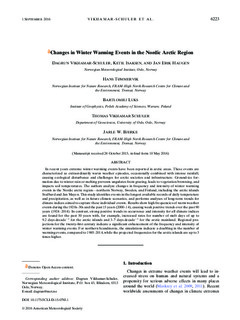Changes in winter warming events in the Nordic Arctic Region
Vikhamar-Schuler, Dagrun; Isaksen, Ketil; Haugen, Jan Erik; Tømmervik, Hans; Luks, Bartlomiej; Schuler, Thomas Vikhamar; Bjerke, Jarle W.
Journal article, Peer reviewed
Permanent lenke
http://hdl.handle.net/11250/2402999Utgivelsesdato
2016Metadata
Vis full innførselSamlinger
- Publikasjoner fra CRIStin - NINA [2364]
- Scientific publications [1392]
Sammendrag
In recent years extreme winter warming events have been reported in arctic areas. These events are characterized as extraordinarily warm weather episodes, occasionally combined with intense rainfall, causing ecological disturbance and challenges for arctic societies and infrastructure. Ground-ice formation due to winter rain or melting prevents ungulates from grazing, leads to vegetation browning, and impacts soil temperatures. The authors analyze changes in frequency and intensity of winter warming events in the Nordic arctic region—northern Norway, Sweden, and Finland, including the arctic islands
Svalbard and JanMayen. This study identifies events in the longest available records of daily temperature and precipitation, as well as in future climate scenarios, and performs analyses of long-term trends for climate indices aimed to capture these individual events. Results show high frequencies of warm weather events during the 1920s–30s and the past 15 years (2000–14), causing weak positive trends over the past 90 years (1924–2014). In contrast, strong positive trends in occurrence and intensity for all climate indices are found for the past 50 years with, for example, increased rates for number of melt days of up to 9.2 days decade21 for the arctic islands and 3–7 days decade21 for the arctic mainland. Regional projections for the twenty-first century indicate a significant enhancement of the frequency and intensity of winter warming events. For northern Scandinavia, the simulations indicate a doubling in the number of warming events, compared to 1985–2014, while the projected frequencies for the arctic islands are up to 3
times higher.
